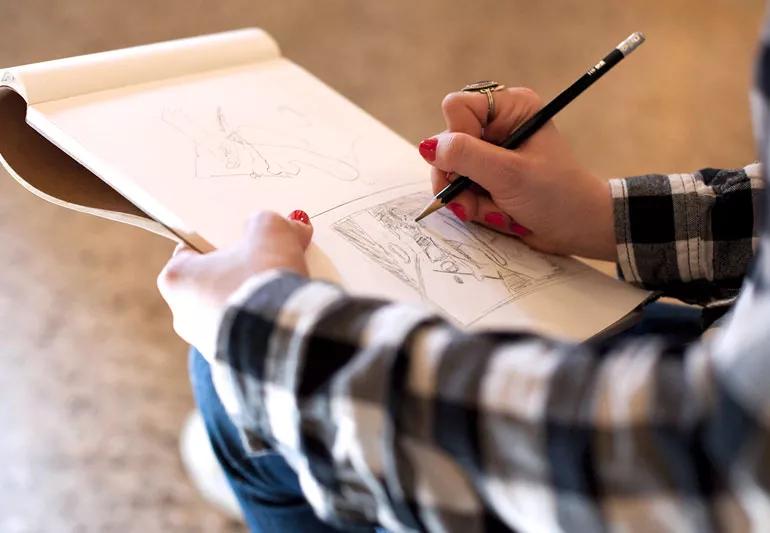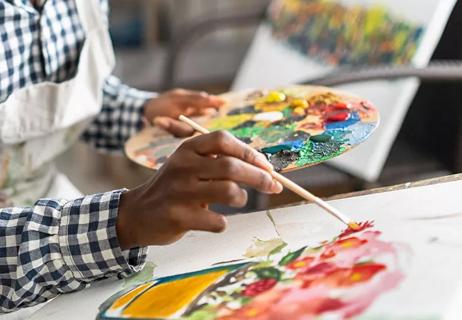Advertisement
Use your creativity to relieve stress — and show people how much your really care

Many of us lived for art class. It gave us a chance to be pint-sized Picassos with paint or Michelangelos with elbow macaroni. We didn’t let our egos or skillsets get in the way. Instead, we rolled up our sleeves, unleashed our creativity and beamed with pride when we presented our “masterpieces” to loved ones. We were more than happy to make things for the special people in our lives back then. Through our arts and crafts, we could show them just how much they meant to us in our own unique ways.
Advertisement
Cleveland Clinic is a non-profit academic medical center. Advertising on our site helps support our mission. We do not endorse non-Cleveland Clinic products or services. Policy
In a time when we can’t see friends and family as much as we used to, some might be struggling to find the right ways to stay connected — and show our VIPs that they still mean the world to us. Sure, the video chats, virtual dance parties and game nights were fun at first. But with the heaviness of the last few months, high-tech communication solutions have started to lose their luster.
So how can we reconnect with our loved ones in genuine ways, nourish our minds and lift our spirits, especially with the holidays fast approaching? It’s all rooted in art.
Art therapy manager, Tammy Shella, PhD, ATR-BC, is going to help us understand how important art can be to stress management and how we can use it to stay connected to the people we love.
According to the CDC, the pandemic has been the source of many mental health challenges. Most have been related to illness and death caused by the disease, physical distancing and even stay-at-home orders. A recent survey done by the CDC revealed that cases of anxiety disorder and depressive disorder increased considerably between April and June in the United States. Of those who participated in the survey, 40.9% reported at least one mental or behavioral health condition — anxiety, depression, trauma-and stressor-related disorder or even increased substance abuse. Some survey participants even reported that they considered suicide in the 30 day period before they recorded their responses.
Advertisement
After experiencing so much loss, it’s not hard to get stuck in a loop of sadness and despair. It’s also understandable if you feel lonelier than usual or have an even greater need to remain isolated. However, maintaining personal connections is one thing that we can control. And when all hope is lost, the people we love can help us remember that good things still exist in the world.
As an art therapist, Tammy Shella has seen how creativity can ease stress and help people process the heaviness that they’re dealing with. While your stick figures or crocheted toilet paper covers won’t win you any awards, creating them can help nurture your inner artist and help you find some peace.
“We all draw. It’s a natural form of expression, and expressing ourselves visually is human nature. Sometimes, it’s hard for us to say things because the verbal side of your brain and the visual side of your brain are two different paths. For example, post-traumatic stress is stored in the nonverbal areas of our brain. That is why people who have PTSD are triggered by things like sights, smells, colors or sounds that remind them of the trauma that occurred. In their case, talking about the event won’t always bring up the trauma. So because of that, just talking about things won’t necessarily help them heal,” says Shella.
Shella adds that art therapy helps patients process what they might not be able to through traditional therapy sessions.
“Walter Reed National Military Medical Center has a big art therapy program for soldiers with PTSD because it helps them express what they can’t express through words. When you think about it, people who’ve experienced major traumas can’t explain what they’re going through. And when we have a difficult time expressing what we’re going through, we might have feelings of shame, anger and depression all wrapped up inside. We might also mask our emotions to appear strong to those around us. But through art therapy, patients can convey how they really feel on the inside and reveal things that they weren’t comfortable sharing with the world.”
While the program that Shella manages is mainly for hospital patients, she says that we can greatly benefit from creating art at home. And a good reason to do it right now? It can give us a much-needed mental break from current events and allow us to be more mindful.
“When you’re creating art, whether it’s writing in a journal, singing or making a card, you’re getting into what’s called a ‘flow state.’ Psychologist Mihaly Csikszentmihalyi, one of the cofounders of positive psychology, describes flow state as a period of optimal attention. During this time, you’re in the zone and completely focused on the task at hand. You’re not worried about the time, bodily sensations or any other needs. And working on your creation can be quite euphoric,” says Shella.
Advertisement
She says that the flow state is a good place to be. When we go there, we can stimulate our minds, embrace mindfulness and experience feelings of accomplishment or mastery.
Another benefit of tapping into our creativity is that we can use it to come up with new ways to connect with the people who are important to us.
“Communication has become so easy. We can text. We can just pick up the phone and call people. We can get a hold of someone across the country or FaceTime them immediately. The neat thing about making cards or writing letters is that you can express yourself in ways that you wouldn’t necessarily express yourself face-to-face. For example, telling someone that you love them can sometimes be difficult to do verbally. But it might be easier to write it in a letter or a card. You can express your feelings and you don’t have to worry about any awkwardness after the recipient reads it,” explains Shella.
“It becomes an altruistic act. Even though you’re not there to gain the reward of seeing the person get the card or letter, you know the recipient will feel good when they open it. It lets them know that someone was thinking about them. It makes them feel like they’re cared for. And knowing this makes us feel good, too. When you can think outside of yourself, it opens you up and broadens your perspective.”
Advertisement
With the holidays approaching, writing letters or making your own cards are wonderful ways to connect with the special people in your life. If you’re not really a wordsmith, Shella says to find a craft that you really enjoy and go from there.
“There’s really no wrong way to do it. Someone is going to appreciate your finished piece because you made it for them. The skill level doesn’t matter. It’s the thought that counts. The other good thing is that there are millions of sites that will walk you through the process and that still counts as creating. Experiment and remember every artist has failures. Artists throw away or abandon a lot of pieces because they didn’t like the direction that a piece was going in. Try again and keep building your skills. That’s what art is all about.”
As you’re getting started, don’t rush out to the art supply store and drop a fortune on paper, pens, paint or whatever else you need. Shella says you can get creative with things around the house or get supplies at the dollar store. For instance, you can make collages with old magazines or newspapers. Or you can buy canvases and other things at the dollar store and send pictures you’ve painted. You can even pick or buy flowers and make arrangements to drop off to loved ones.
Shella suggests not overthinking things when it comes to creating art for others. And if you don’t want to take on painting writing or drawing, there’s still a lot of sentimental value in sending a bouquet from a flower shop or a store-bought card. It still shows someone that they’re on your mind.
“When you can open up and look outside of yourself, you realize things are not just about you. You start to understand that what we’re going through is a shared experience — and knowing that other people understand what you’re feeling helps us all feel better.”
Advertisement
Learn more about our editorial process.
Advertisement

It’s nothing like your average arts and crafts session

Popular among teens, these inhalants give you a quick high, with serious harmful effects

The color-changing ingredient is caffeine-free and full of antioxidants

This light, gentle technique may decrease swelling, lessen facial puffiness and just help you relax

This sticky phytocomplex may have health benefits — but the science and safety data is lacking

This five-day exercise plan for beginners includes three days of resistance training, two days of cardio and two days of rest

It can take three to four weeks to experience improvement in strength, and up to six months or more to notice visible changes

Research doesn’t show any benefits to wearing copper bracelets — but your experience may vary

If you’re feeling short of breath, sleep can be tough — propping yourself up or sleeping on your side may help

If you fear the unknown or find yourself needing reassurance often, you may identify with this attachment style

If you’re looking to boost your gut health, it’s better to get fiber from whole foods